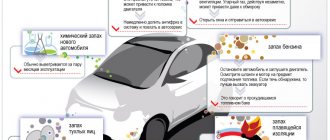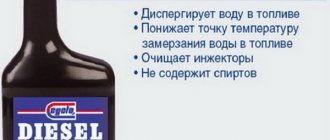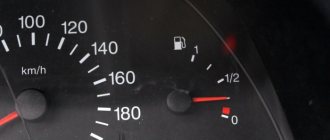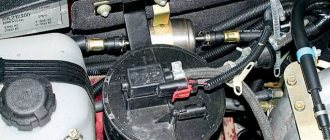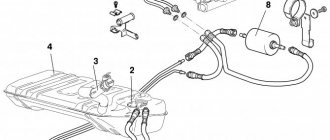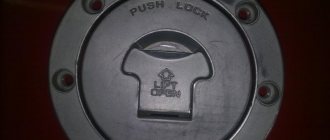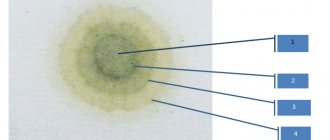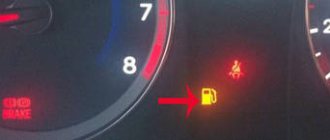Many car enthusiasts know that using gasoline with an octane rating lower than that recommended by the engine manufacturer leads to detonation of the air-fuel mixture in the combustion chambers and, as a result, to a reduction in engine life, or even to immediate failure. Of course, in the city and its environs, you can always buy fuel that suits your car at gas stations. However, if you are a fan of auto tourism, you may come across such remote corners where you would consider it lucky to have any low-octane fuel at a gas station. In this case, it would be good to know how to increase the octane number of gasoline at home. But first, about the fuel parameter itself.
What's the point
First, let’s figure out what kind of indicator this is and why it should be improved.
So, the octane number characterizes the detonation properties of gasoline, that is, its ability to ignite at the right time and with the required quality.
This is the main indicator that receives special attention. For example, if the octane rating of gasoline is AI-95, then this indicates its detonation by 95% (like isooctane) and 5% (like heptane).
At the very first moment after oil refining, gasoline has a minimum octane number of 70. Later, using various methods and additives, this figure can be raised to the desired level.
The octane number is determined on a special stand (often it looks like a special motor for testing). The test is performed under various loads - small and medium.
But recently, special devices have begun to appear that simplify testing.
The parameters of the fuel used for the experiment are compared with standard compositions of isooctane and heptane. After this, gasoline is assigned its own “number”.
By the way, each organic compound has its own level of detonation resistance.
For example, methane has an octane rating of 107.5; propane – 105.7; benzene – 113; butane – 93.6; straight distilled gasoline - about 58, catalytic cracking - about 80-85 and catalytic reforming - 83-97.
This is interesting: How much gasoline is in 1 ton
Driving on inappropriate fuel
It is not for nothing that the manufacturer guides everyone who decides to purchase a specific vehicle which brand of gasoline can be used. If you pour in the wrong fuel, don’t even doubt it, the car will run, but it’s unlikely that the vehicle will please you for a long time.
If the quality of gasoline does not meet the recommended one, the exhaust valves quickly overheat and burn out due to different temperatures and combustion durations. Exactly the same negative effect will be observed when motorists, on their own initiative, subject the ignition to incorrect adjustment. After burning out, the valves initially begin to trip, and subsequently stop functioning.
Most motorists categorically refuse to fill with low-octane gasoline, realizing that such a wrong step will provoke serious technical problems. It is precisely at those moments when they have to pour in such fuel due to the lack of high-octane gasoline that motorists decide to pour in suitable additives.
Universal means
They do everything at once - they remove moisture, increase octane, and wash! Just a “miracle pill” for everything at once.
CONS : I will say this if a manufacturer produces such additives, they usually do not succeed in anything. Or it shows VERY bad results. YES, and the cost is usually off the charts (I’ve seen such drugs for 2,000 rubles).
So it’s better to take a narrowly targeted one for your needs.
Now we are watching the video version.
To summarize, additives work, BUT HOW, WITH WHAT EFFECT? You must understand it yourself. This is where I end, sincerely yours, AUTOBLOGGER.
Similar news
- Gas for cars: pros and cons. Let's look at propane and methane + video
- Removes moisture (water) from the gas tank. With your own hands
- Which gasoline burns faster, longer and better? 92 – 95 – 98 or 100…
Add a comment Cancel reply
Review of known additives
Additives for increasing the octane number in gasoline are produced by both foreign and domestic manufacturers. Unfortunately, many car owners are under the misconception that they can only trust foreign companies offering such octane-boosting additives.
This is not so, since domestic fuel additives for increasing the octane number of Astrokhim gasoline have been repeatedly subjected to various technical tests, the results of which have always demonstrated their high efficiency. It is for this reason that experts rightfully consider Astrochem to be the undoubted leader among well-known octane correctors. Despite its affordable cost, the additive guarantees:
- detonation prevention;
- elimination of glow ignition.
Among avid motorists, you can hear many enthusiastic compliments addressed to the German product - LMOP, which is capable of “magically” turning ordinary 92 gasoline into high-quality ninety-five.
The American product Cyclo Octane Boost not only demonstrates excellent anti-knock characteristics, but also provides an excellent cleaning effect on fuel system components.
To improve the octane rating of gasoline, many people prefer to use the time-tested, tested FuelEXx Gazoline. It provides:
- cleaning the combustion chamber from carbon deposits and varnish deposits;
- decarbonizes the piston rings;
- reduces the risk of valve burnout;
- removes water from the fuel, ensuring easier engine starting even when the temperature drops.
Thanks to the use of FuelEXx Gazoline, it is possible to reduce fuel consumption by 15%, increase the octane rating to five units, and prevent premature engine wear.
Effect of additives
Of course, high-octane fuel is a big plus for the engine. The latter works more stable, power increases, fuel consumption decreases, and so on.
That is why the obsolete and inefficient types of fuel AI-76 and AI-80 are gradually coming out of use. But there are certain risks here too.
If you fill your car with gasoline with a “makeshift” increased octane number, you may encounter a number of problems, starting with the usual replacement of spark plugs and ending with a major engine overhaul.
Other additives.
Offers on the market.
Why change the octane setting?
With a low octane number, gasoline may ignite much earlier than necessary. In this case, the engine power decreases, and the detonation process, well known to many car enthusiasts, appears.
In addition, the use of low-octane gasoline leads to engine detonation, reducing the service life of a whole group of its main elements - seats, valves, spark plugs, and so on. If you abuse low-quality fuel, the engine will have to be overhauled much earlier than scheduled.
So in order to improve the quality of gasoline and significantly improve its performance, it is still necessary to increase the octane number.
How it's done? What are the features of each method? This is exactly what we will talk about in more detail.
Detonation resistance
Octane number, or octane index, is a parameter that characterizes the ability of gasoline not to ignite under compression. The indicator is equal to the volumetric percentage of isooctane in a mixture with n-heptane, at which the detonation resistance of this liquid and the gasoline under study is the same. Isooctane is extremely reluctant to ignite even at a very high compression ratio, so its octane number is taken to be 100. H-heptane, on the contrary, easily self-ignites even at a low compression ratio, therefore the value of its anti-knock parameter was set to zero.
The first to study the ability of gasoline to detonate in the 21st century was the Englishman Harry Ricardo. He suggested using a scale of gasoline resistance to detonation. For a long time, the main anti-knock additive for gasoline was tetraethyl lead. Adding just 0.01% of this substance to gasoline increases its knock resistance index by 3 units. But since it is very poisonous, its use as a gasoline additive is now prohibited. Instead, in order to increase anti-knock properties, safer additives are now used, for example, methyl tert-butyl ether, which is considered today the most promising means for this purpose. Its mixture with tert-butyl alcohol is also used. The disadvantages of these additives are their high aggressiveness towards rubber products and low (about 50 ◦C) boiling point. The latter is the reason for the evaporation of these additives from the fuel in the heat.
Regardless of the chemical nature of the antiknock agent, the concentration of the additive in gasoline is limited for objective reasons, which leads to a low increase in octane number. In addition, the increase in the gasoline knock resistance index depends nonlinearly on the additive concentration. For each antiknock agent there is a threshold concentration, after which the detonation resistance indicator does not increase.
Comparison of the properties of various antiknock agents
Threshold concentration values for some additives and their other operational features:
- Oxygenates (lower alcohols and ethers). The threshold concentration of the additive is 15%. Features: relatively low heat of combustion and high aggressiveness towards rubber products. The maximum increase in fuel octane index is 4–6 units. Parameters of several esters used as additives. Methyl tert-butyl (MTBE) – average octane number 114, boiling point 55 ◦C; ethyl tert-butyl (ETBE) – average octane number 110, boiling point 70 ◦C; methyl tert-amyl (MTAE) – average octane index 104.5, boiling point 87 ◦C; diisopropyl (DIPE) – average octane index 104.5, boiling point 69 ◦C.
- Lead based additives. The threshold metal saturation of gasoline is 0.17 g/l. Features: high level of toxicity and carbon formation in the combustion chamber. The maximum increase in the gasoline detonation resistance index is 8 units. Such additives are not used nowadays.
- Containing manganese. The threshold concentration of metal in fuel is 50 mg/l. Features: increased wear of parts of the cylinder-piston group, significant carbon formation on the spark plugs and in the combustion chamber. The maximum increase in the detonation resistance index is 5–6 units.
- Iron-containing. Threshold concentration – 38 mg/l. Leads to increased wear of engine pistons and cylinders due to noticeable ash deposits during combustion. The maximum increase in the number of detonation resistance of gasoline is 3–4 units.
- Aromatic amines, for example, aminobenzene (aniline), which is prohibited for use in its pure form due to its extreme toxicity. Of the substances in this group, only monomethylaniline (N-methylaniline) is approved for use. Threshold concentration 1–1.3%. The peculiarity of the additive based on this substance is its high octane number. During the experiment, a value of 280 units was obtained. However, there are also significant drawbacks, which include significant resin deposits on engine parts and fuel system. There is also increased wear of parts of the cylinder-piston group. The maximum increase in the number of knock resistance of gasoline achieved by using such an additive is 6 units.
This is interesting: How much oil to fill in a 127 engine
Methods for increasing octane number
There are cases around gas stations when, instead of the required AI-95 or AI-98 gasoline, only AI-92 is available.
What to do in this case, if it is known that it is undesirable to pour such fuel into the tank?! In addition, the non-compliance of fuel with the requirements is clearly felt when accelerating a car or on a steep climb. The vehicle not only loses its dynamics, its power also drops noticeably. In this regard, it remains to try to increase the octane number on your own. How can I do that? There are a variety of methods and almost all are based on the use of special octane-increasing additives for gasoline. Let's consider several options and at the same time find out who you can give preference to.
Methyl tert-butyl ether
It is safe to say that this is the most promising component. Methyl tert-butyl ether (MTBE) has high detonation resistance - from 115 to 135 units. As a result, this has a positive effect on the operation of the power unit. The working air-fuel mixture burns completely, which helps reduce the content of CO and CH in the exhaust gases.
MTBE is a liquid with certain technical parameters:
- has no color;
- transparent;
- has a pungent odor;
- boiling point – from 48 to 55°C;
- density – from 740 to 750 kg/m3.
But there is also a minus here - the increased content of MTBE in gasoline (more than 20%) leads to a decrease in engine service life. In addition, this also contributes to an increase in nitrogen oxides, which enter the atmosphere along with exhaust gases.
For this reason, in Russia it is permissible to use gasoline with an MTBE content of no more than 15%. And as road tests show, unleaded gasoline containing 7-8% MTBE turns out to be much better than commercial fuel.
In addition to the disadvantage mentioned, methyl tertiary butyl ether leaves a red deposit on the surface of the combustion chamber or spark plugs. In this case, characteristic symptoms can be traced - a decrease in the car’s power, including engine tripping. The spark plugs themselves may simply fail over time.
Alcohol based additives
Another technique for increasing the octane number of fuel is the addition of alcohol, mainly ethyl and methyl. 10% ethanol is enough to get AI-95 from the AI-92 grade. Such an additive for increasing the octane number of gasoline can minimize the amount of toxic substances in exhaust gases. However, we cannot exclude the possibility of an increase in saturated vapor pressure, which may cause vapor locks to appear in the fuel line.
It is also worth noting the peculiarity of storing alcohols. The fact is that these are active moisture absorbers from the air and, in addition, are highly soluble in water. For this reason, alcohols require specific storage conditions and control of the alcohol component. As soon as these rules are violated, water will appear in the gasoline, which inevitably promises not only excessive fuel consumption, but also its incomplete combustion. And if there is more of it, then in winter you simply cannot avoid ice jams.
Another disadvantage of this additive is that it leads to corrosion of engine gaskets. As a result, separate layers form in a tank of gasoline, and if water gets in there, then here it is - vodka (when it is absorbed by alcohol). And every car enthusiast knows that any engine will not work on this popular product.
Lead tetraethyl
It is also referred to as tetraethyl lead or TEL (formula Pb(C2H5)4). It is a colorless liquid of oily consistency with a boiling point of up to 200 °C. The use of this substance as an anti-knock agent began in 1921. But to this day, TPP remains a surefire way to increase the octane number. The content of this additive in an amount of 0.05% helps to increase the octane number of gasoline by 15-17 points.
In its pure form, tetraethyl lead is not added, since lead oxide, which is formed during the combustion of thermal power plants, is deposited on pistons, valves and other parts as carbon deposits.
In addition, adding Tetraethyl Lead to gasoline has positive aspects:
- Exhaust smoke is reduced.
- The engine is quieter than before, almost whispering.
- The power of the power unit also increases, albeit slightly.
- The likelihood of detonation is noticeably reduced or eliminated altogether.
Now is the time to touch on the other side of the coin - lead theatratel itself is highly toxic and therefore poses a threat to the human body. But its fumes can enter not only through the respiratory tract, but also through existing open wounds on the body.
In addition, TES has an increased neuroparalytic effect on a person, which can cause not only paralysis, but also death. In this case, the car also suffers - lead compounds are deposited in the pipes and pipes, which is fraught with negative consequences. This is especially critical in relation to engines with a carburetor and injection analogues.
Naphthalene
Our grandmothers are very familiar with this remedy, since at that time it was the most common and effective method of fighting moths and other living harmful entities. Now it has a slightly different application - from 92 gasoline to obtain fuel with an index of 95. Just 500 grams of the crystalline substance per full canister of gasoline increases the octane number from 3 to 5 points.
However, such an additive is not as harmless as it might seem at first glance - it promises trouble for many engine systems. The result of constant use of naphthalene in gasoline ends up with carbon deposits in the combustion chamber.
It also begins to crystallize, causing hoses to become clogged, including the fuel pump and injectors. And in addition, such an additive increases the toxicity of exhaust gases.
Acetone
Those owners of movable property who have extensive experience driving a car use acetone to increase the octane number. To do this, adding one liter to a standard 20-liter canister is enough. As a result, the indicator increases by 6 units. You don’t need to look far for an example - a car whose engine is designed for AI-98 gasoline was filled with AI-92 fuel and acetone was added in the specified ratio (1 liter of substance to 20 liters of gasoline). The result of this combination is the absence of detonation.
Government rules and regulations legalize the addition of acetone to gasoline and in connection with this (for obvious reasons), most manufacturers prefer to increase the octane number in this way. However, there is one problem here too.
Monomethylaniline
This is another effective way to increase the octane number of gasoline. This substance is part of the class of substituted aromatic amines. Monomethylaniline or MMA can be used in small dosages - from 1 to 1.3%. At the same time, no negative impact on the power unit and its systems is observed.
However, this is true if you do not exceed the indicated dosage. Otherwise, increased carbon formation cannot be avoided, which in turn ends in valve hanging.
It should also be borne in mind that MMA is also a poison and if you inhale its vapors you can be poisoned.
Detergent additives
Currently, almost every oil company specializes in the production of detergent additives for gasoline. They contain various components:
- corrosion inhibitors;
- demulsifiers;
- the detergents themselves.
In other words, any detergent additive (and there are quite a few of them) is a package where all components are optimally balanced. This allows it to corrode carbon deposits and other deposits. The smallest particles that appear fall into the cylinder and burn.
If we draw a parallel, such additives act as washing powder or shampoo. After all, all these compositions contain surfactants that can dissolve in gasoline. Only, unlike regular washing powder, surfactants in detergent additives have stronger characteristics.
It’s just important to take into account that here, too, the dosage must be observed - no more than 10%! Otherwise, the engine will start with difficulty or may even fail.
Features of domestic fuel
Almost every motorist knows very well what the quality of domestic fuel is. In most cases, to obtain a normal octane number for gasoline, it is additionally necessary to add certain additives to it. Of course, such frugality will help maintain the performance of your car and prevent serious breakdowns in the fuel system.
A fuel additive is a unique tool that allows you to fill the liquid with a sufficient amount of the necessary chemical components. Keep in mind that gasoline itself is the result of refining petroleum products. It contains a large amount of hydrocarbons, which are responsible for the operation of the internal combustion engine. At the same time, gasoline contains additional components that can negatively affect the condition of the power unit.
It is impossible to exclude them from gasoline. At the moment, there are no processing methods that would completely clean the fuel from additional resinous inclusions. Normally, they may contain about 10-100 mg per liter of fuel; anything more can no longer be sold at civilian gas stations. Depending on the supplier, the quality of the fuel may vary significantly - this is why you should find a gas station where you can purchase high-quality fuel.
If you compare gasoline and diesel, you can highlight a number of features. Diesel fuel contains more resins. To prevent them from harming the car engine, various acids are additionally added to the fuel composition. Their main purpose is to dissolve resins. If there are not enough of them in the composition, then resins begin to accumulate on metal surfaces. As the resin burns, it covers the entire engine chamber, after which it begins to act up. In addition, resins accumulate:
- In the fuel tank.
- On the spark plugs.
- Directly in the combustion chamber.
- In the exhaust manifold.
- On piston rings.
- In the carburetor.
Is it worth filling
In order not to ruin your car’s engine, it is important not to thoughtlessly purchase additives at a car dealership and pour them into the unit uncontrollably, but to initially arm yourself with the recommendations of specialists and weigh all the arguments for and against the use of additives.
It is important to take into account that cunning enterprising businessmen, seeking to sell low-quality fuel at a higher price, even before selling it, add octane-increasing additives to the composition, misleading motorists. As a result, after the next portion of the additive is introduced directly by the car owner, a glut of additives occurs, which negatively affects the condition of the engine. For this reason, it is not recommended to use auto chemicals unless necessary. It will be much more efficient to get service at gas stations that you trust.
So, octane-boosting additives are indeed good, but they must be used within reasonable limits so as not to provoke technical problems or failure of the car engine.
How to use additives?
To get the maximum benefit from using fuel additives, they must be used correctly. Read the instructions for use in advance, and only then proceed to use. First of all, you need to prepare the engine, it should be washed. This is done in the following cases:
- Before a complete oil change.
- If you switch to another engine oil brand.
- If you need to restore your car after using low-quality petroleum products.
- After completion of repair work.
To flush the engine, you must use special flushing oils. You can buy them in special stores. Keep in mind that flushing oil is a transition component. It is used when it is necessary to switch to another engine oil. If you want to use fuel additives, use them only if you fill the tank full.
As fuel passes through the combustion chamber, the engine gets rid of soot and deposits. The rings of the piston system are gradually cleaned. To get maximum benefit, it is necessary to add additional additives to the engine lubrication system. After filling the fuel additive, you must drive especially carefully for the first 300 kilometers, not to overload the system with additional load.
Functional action
As the octane number of gasoline increases, the likelihood of its self-ignition decreases. Therefore, the use of various octane correctors (made in the USA, Germany and Russia) will not only provide the engine with safe starting conditions, but also guarantee its increased durability. The use of such additives ensures an increase in octane number up to 6 units inclusive. By the way, similar additives - cetane correctors - have been developed for diesel fuel.
The effectiveness of octane correctors for gasoline depends on the brand of fuel, as well as on who produces it (different manufacturers add special additives to gasoline that can affect the final result). It is important that the products in question are not always advisable to use, but only in cases where the engine uses a higher compression ratio during its operation or supercharging or turbocharging is used to increase the flow of air into the engine.
Increasing the pressure in the cylinder allows the engine to extract more mechanical energy from the air-fuel mixture, but at the same time requires a higher octane number for the fuel used: then the mixture will not be subject to pre-detonation. Consequently, high octane fuel will improve performance and fuel economy.
A correctly selected gasoline octane corrector provides:
- Improving the operation of the car control system.
- Increasing engine power.
- Reduced fuel consumption.
- Elimination of unpleasant “knocks” in the engine.
- Reduces the percentage of carbon dioxide in exhaust gases, especially during operations such as towing or transporting heavy loads in hot weather.
As the percentage of ethanol in gasoline increases, its octane number increases, but it is not recommended to add ethanol to gasoline yourself; It is better to use proven brands of appropriate additives.
What is detonation?
Detonation
- this is the process of self-ignition of the mixture in the engine (due to low-octane gasoline or due to increased pressure in the combustion chamber if, for example, you installed a turbine). In other words, this is an uncontrolled ignition process, the most dangerous and destructive process for a gasoline engine. Detonation differs from controlled ignition of a mixture (combustion) in the explosion area, its strength, and the inconsistency of the mechanisms. The combustion speed increases from the usual 15-20 m/s to 1.5-2 km/s! There really is an explosion.
